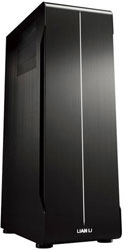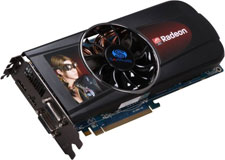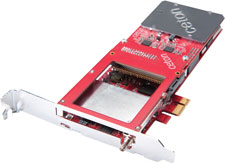Holiday 2010 System Builder's Guide
by AnandTech Staff, edited by Jarred Walton on November 19, 2010 2:00 AM EST- Posted in
- Guides
- Systems
- Holiday 2010
Alan's Ultimate HTPC: Bringing Total Entertainment to the Living Room
Our final build is for those of you who do not like to compromise with your HTPC. Are you tired of hooking up multiple streaming boxes to get all your internet content, NAS for secondary streamers, and another gaming system as well? There are numerous users out there, myself included, that love HTPC as well as gaming. There are many ways to skin the proverbial HTPC cat; this guide is for those of you who want it all in one box on your big screen. There will be sacrifices however, and those come in the size department and in the old pocket book. If you're looking for a small, quiet HTPC that isn't as powerful but doesn't cost an arm and a leg, go look at what Ganesh is pushing.
| Alan's Ultimate HTPC | ||
| Hardware | Component | Price |
| Processor |
Phenom II X6 1090T Black Edition (Thuban 45nm, 3.2GHz, 6x512K L2, 6MB L3, 125W) |
$210 |
| CPU HSF | Noctua NH-D14 | $75 |
| Motherboard | MSI 890FXA-GD70 (AMD 890FX AM3) | $200 |
| Video | Sapphire Radeon HD 5870 1GB (100281-3SR) | $300 |
| GPU HSF | Arctic Cooling Accelero Xtreme | $57 |
| TV Tuner | Ceton InfiniTV4 CableCARD Quad-Tuner | $400 |
| Memory |
G.Skill Ripjaws 2x4GB DDR3-1600 CL9 (F3-12800CL9D-8GBRL) |
$150 |
| OS Drive (SSD) | OCZ Vertex 2 120GB ($20 MIR) | $210 |
| Misc | Icy Dock MB882SP-1S-1B | $20 |
| Hard Drives | 3 x Western Digital Green 2TB (WD20EARS) | $300 |
| Optical Drive | LG UH10LS20 Blu-ray Combo Drive | $85 |
| Case | Lian Li PC-X2000F | $300 |
| Power Supply | Seasonic SS-560KM 560W (80 Plus Gold) ($15 MIR) | $115 |
| Mouse | Razer Mamba | $110 |
| Keyboard | Logitech diNovo Edge | $157 |
| Software | Windows 7 Professional 64-bit (OEM) | $135 |
| Software | Hipporemote Pro | $5 |
| Software | PowerDVD 10 Ultra | $90 |
| Misc | Powermat for iPhone 3GS (PMM-1PB-B2A) | $41 |
| Total System Price | $3015 | |

The first thing to look at for an HTPC is the case, and the most important feature in the case of an HTPC is noise. This is the major problem with multipurpose machines. Gaming cases tend to stay cool but also tend to be noisy and filled with enough LEDs to be mistaken for a flight beacon; after all gamers tend to want to highlight all their high-end hardware. Finding components that will both be cool enough for gaming and quiet enough for a home theater is the key here. A great best of both worlds case is the Lian Li PC-X2000F. At $299 from Newegg as of this writing, the case is pricey, but it currently sports a $200 saving (though that may disappear soon). At that price, I think it is an excellent buy for a home theater/gaming enthusiast.
New to this version is USB 3.0 support and a redesigned case layout. With five 140mm fans, dust filters, and anti vibration solutions, the air-cooling is both highly effective and extremely quiet. Sporting seven HDD bays with the installed back plates for hot-swappable fun, this case has plenty of room for media drives; just make sure your motherboard or RAID card have enough SATA connectors.
Speaking of storage, currently 2TB WD20EARS drives are shipping for $100 and are a great way to expand your media storage capabilities and tend to run on the quiet side of things—no need for a NAS when your HTPC case holds enough traditional HDDs to feed every other device in your home with media! The case is limited to 3.5" drives, but throwing your favorite SSD into an Icy Dock or similar device will allow you to push it right into one of the HDD back plates to get your OS and applications loading at high speed with no noise whatsoever.

For the GPU, I chose AMD because of the bitstreaming support for HD audio codecs. We can argue about performance with the 5870 and 6870, but the 5870 has been around enough that aftermarket cooling solutions are readily available. Add a Noctua cooler to your favorite CPU as well as an Arctic Cooler Accelero on your high-end AMD graphics card for cool and quiet gaming that won't leave you straining to hear during quiet movie scenes. We've also selected a high-efficiency, near-silent 560W power supply from Seasonic to keep everything running; the GPU + CPU combination generally means we need more power than a typical HTPC, but since this is the main feature of the Home Theater/Gaming we went higher end.
At this point, we've taken your NAS or Windows Home Server, HTPC, and gaming PC and combined them into one glorious entertainment system. You'll need help accessing all that media however. Free applications like Boxee and My Movies 3 can help sort local and internet content past what Windows Media Center offers, but pay applications like PowerDVD will integrate well with Media Center and will also play nice with My Movies adding Blu-ray capability into the mix. But there's still more….
The smartphone is one of the best ways I have found to control a Windows-based HTPC. With HippoRemote on your phone and HippoVNC booting on your PC, you can use your smartphone to seamlessly open Windows Media Center, Boxee, Hulu, or myriad other applications. The touchscreen on the phone then transforms into a remote interface designed for the application of your choice. It is a great way to navigate seamlessly between applications that bring you internet or media content without having to browse endless webpages, and there's no need to hack Media Center. The problem is, using your smartphone in this manner depletes the battery at a rapid rate; that's why adding a Powermat on the coffee table will address this problem and charge your smartphone/remote each time you set it down. You'll still want a good wireless mouse as well as a keyboard for gaming. I like the Razer Mamba mouse, while the Logitech Dinovo Mini or Edge are excellent options for the keyboard.

Last but not least, you can add cable TV into your HTPC with a Ceton InfiniTV 4 CableCARD tuner. Although quite expensive and backordered, they bring four simultaneous HD streams into your PC through a single card. Streams can be accessed in other rooms via the Xbox 360, or by adding a network bridge to the tuners (a process still in beta firmware, but it should be available by the time the cards are out of backorder). Or, if you're one of those looking to cut the cable, save $400 and stick with streaming video.
You can see my list of components up top, but play around with what works best for you. I went with an AMD setup to keep the cost slightly lower and chose a single GPU as the system will likely be hooked to an HDTV that will limit the resolution for gaming to 1920x1080. Sadly, the single most expensive item is the CableCARD tuner. But for around $3000, you'll be ripping Blu-rays onto 6TB of storage, controlling your media with your phone, and playing the latest games on your 1080p TV. Enjoy!










112 Comments
View All Comments
PubicTheHare - Monday, November 22, 2010 - link
I see the case pictured in the "cover," but I don't recall any of the systems using this case. I know this case is highly regarded for it's airflow and design. Are some of the cases selected better in these regards, or is case selection truly that personal and cases within the same price range tend to perform the same?JarredWalton - Monday, November 22, 2010 - link
It's from Newegg's EggXpert system (see the shout out in my config on page 4), and it's a good case. I chose the Antec Three Hundred simply because there was a combo offer with the PSU to save $30, but I've used the HAF in a build before and liked it a lot. Anyway, mostly the picture was used simply to have a picture there with an introductory text. I figured some readers would notice the components didn't exactly match anything we selected, but I didn't think it would really matter. :-)pvdw - Friday, November 26, 2010 - link
For a near silent PSU go with the Nexus Value 430, or for more power the Seasonic S12II range.The0ne - Monday, November 29, 2010 - link
Just wanted to say thanks for making the guide base off of each reviewers choice. Personally I think this is a better way to approach a guide and sometimes a review than relying one one person.scarfinger68 - Monday, November 29, 2010 - link
With the help of great sites like AnandTech I finally put together a new system.COOLER MASTER HAF 922
AMD Phenom II X6 1090T Black Edition
ASUS M4N98TD EVO AM3 NVIDIA nForce 980a SLI ATX AMD
(2 for SLI) ASUS ENGTX460 (Fermi) 768MB 192-bit GDDR5
SeaSonic X750 Gold 750W GOLD Certified
CORSAIR XMS3 8GB (2 x 4GB) 240-Pin SDRAM DDR3 1333
(2)Western Digital Caviar Blue 250GB 7200 RPM SATA
Windows 7 Home Premium 64
It may not be perfect but its mine now. With shipping it came in at $1297.
Thanks again,
Joe
rdh - Tuesday, November 30, 2010 - link
That Athlon II X4 640 comes with a free MSI motherboard (or $10 upgrade to a choice of other Motherboards) at Microcenter. That would knock $75 off your price.I upgraded to the MSI msi 785g-e53 for $10 more. Total price was $106 for CPU and Motherboard after the $20 rebate. Also, there have been a rash of 4GB(2x2gb) DDR3 memory sales for $35 or $40 AR. Microcenter had the AData memory for $50 , no rebate.
In all, you can EASILY knock almost $90 off your budget price... enough for a Radeon 5670/4850/5750 Graphics adapter to create a TRUE budget gaming system for about $370.
rdh - Tuesday, November 30, 2010 - link
ps... only applies if you have a Microcenter... or someone who will match them... nearby.rufwork - Sunday, December 5, 2010 - link
I've been looking through NewEgg with this guide "in hand", and it appears there are several AM3 options that'll save a few bucks if you BYOV[ideo card]. That said, I couldn't quite get enough on Northbridges to figure out where I'm actually saving money and where I'm settling for less.Like the GIGABYTE GA-MA78LMT-S2 is currently $65 and $55 after rebate, but it has a 760G Northbridge. Enough to scare me away? The Intel budget system made do with two RAM slots, so I think that's okay. And it looks like it's still got an IDE plug for my old DVD and hard drives.
I'd like to conserve as many parts from my last white box, built five years ago, and the "recycler's low end" system is still a bit of an unknown. This is largely my fault for not keeping up with SATA, PATA, PCI-e/x, etc, but I'd love to see it all laid out for those with parts still laying around. Drives (hard and optical), cases & PSUs, and video cards seem to be the things with the best reuse potential -- but even PSUs might have new 8 pin connectors?
Alternatively, where would an out of touch buyer go?
(My first Celeron whitebox used an ISA sound card I borrowed from a friend's junk heap... I'm all about the reuse.)
FullHiSpeed - Friday, December 17, 2010 - link
I would love to reach for the stars and have Brian's 24 thread dream machine (or see how it performs).If you're not ready to spend $3760 on CPU, MB, and RAM, you can get 2/3 the number of threads for 1/3 the price like this:
SUPERMICRO MBD-X8DAL-i-O Dual LGA 1366 Server Motherboard $289.99
16 logical processors - Xeon E5620 2.4GHz 80W Quad-Core CPU 2 *$384.99= $769.98
12g GB RAM - 2 x Kingston (3 x 2GB) DDR3 1333 ECC KVR1333D3E9SK3/6G 2 * 90.99 = $181.98
That's the guts of a 16 thread machine for $1,241.95
Stormblade - Tuesday, January 4, 2011 - link
I was all set to start building my machine. I based it on the High End Gaming system here. I'd gone so far as to add the parts to my cart. Came back to check on something and I see the article about Sandy Bridge. Well now I gotta re-think.Definitely want to get an i7-2600K but which motherboard? I see the Asus P8P67 being coupled with it so was thinking of basically still getting the system described but getting that MB and CPU instead. Any thoughts on whether this is a horrible idea or not?